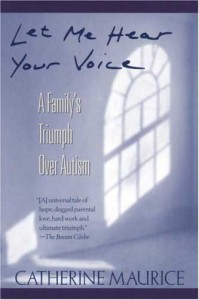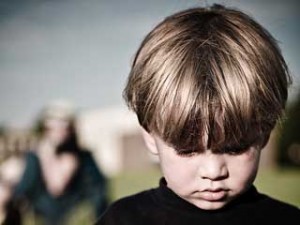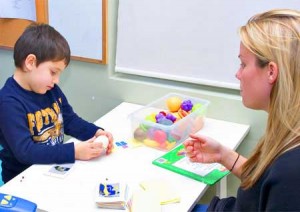It was my father who gave me my first gut-level comprehension of the word ‘autism.’ ‘From the Greek for ‘self,’’ he said. ‘The same root as ‘autonomous,’ ‘automatic’: That which is self-contained, self-directed, self-motivated.’ … When had Anne-Marie shared anything with me in the past year? When had she last responded to me, connected with me? If there was anyone there at all behind that mournfully empty face, she was not reaching out to us in any way that I could see (Maurice, 1993, p. 32-33).

In her book, “Let Me Hear Your Voice: A Family’s Triumph over Autism” (Maurice, 1993), Catherine Maurice shared her uncertainty, confusion, and immediate hopelessness upon hearing the word autism as a description of her daughter, Anne-Marie. Indeed, many mothers and fathers feel a sense of uncertainty when their child is lining up cars instead of pushing them and confusion when their child does not respond to their own name. Most of all, parents are heart broken and feel hopeless when hearing that their beloved child has autism, for when a child is deemed autistic, they are also deemed to a, “‘severely, lifelong disability’” (Maurice, 1993, p.22). As well, parents are thrust into an unknown world that is autism and must form a path out by researching what autism is and finding appropriate treatment to help their child. Parents will soon learn that autism covers an array of characteristics and that the word “autism” lies on a continuum along with disorders such as Rhett’s, Pervasive Developmental and Asperger’s (Diagnostic Statistical Manual of Mental Disorders, Fourth Edition, 1994). They must also weave through countless approaches to treating autism until they come across Applied Behavioral Analysis, a form of behavior modification that is scientifically proven to be successful in treating autism (Lovaas, 1987).
The Occurrence of Autism
Autism afflicts approximately 5 children per 10,000. Ritvo et al. (1989) has indicated a genetic basis in autism, but it is not considered a causal factor in the etiology since none has yet to surface. Ritvo et al. (1989) cited 20 families out of 207 having more than one autistic child. They also noted that there is no correlation between autism and racial makeup, religious affiliation, parental employment and education (Ritvo et al., 1989). Thus, autism can “crash” into a family of any race and educational background and crush any hopes and dreams they may have had for their child. While autism is blind to race, religion, and socioeconomic status (SES), it is not blind to the sex of the child. Autism afflicts more boys than girls with a ratio of 4:1 (DSM IV, 1994). Girls are also at an increased risk of severe mental retardation and maladaptive behavior problems such as face hitting, a form of self-injurious behavior (DSM IV, 1994).
Characterizing Autism
The varied behaviors of autism make the disorder extremely difficult to detect. While some children acquire language and can play appropriately, others can be mute and play in odd eccentric ways. As with many other parents, Catherine Maurice (1993) was puzzled by her daughter’s peculiar behaviors at 1 year of age. Maurice (1993), however, brushed off any of her daughter’s behaviors to, “the uniqueness of [Anne-Marie’s] personality,” since, “she was passing her regular pediatric checkups with flying colors” (p.5). It is true, as in Maurice’s (1993) case, that in approximately 20% of children, development is normal in the first 2 years of life (DSM IV, 1994). Between the second and third year of life, however, parents report a regression of language and then finally an abrupt stop in development (DSM IV, 1994). According to the DSM IV (1994), there are core deficits and excesses in autism that must occur before the age of 3 for a proper diagnosis.

Main deficits in children with autism can affect communication, play and social interaction (DSM IV, 1994). Impairments in communication are primarily associated with expressive and receptive language. Language can be delayed (DSM IV, 1994), or non-existent in which other forms of communication such as Picture Exchange Communication (PEC) might be used (Bohdanna Popowycz Kvam, personal communication, November 1, 2002). Language can also be impaired in the form of a lack of spontaneity (i.e. “I see a car”) or reciprocal statements (i.e. “Tickle my tummy”), pronoun reversal (i.e. “This is your [instead of my] bedroom”), echolalia in which children repeat words said to them and in, “pitch intonation, rate, rhythm [and] stress” (DSM IV, 1994; Schopler, Riechler, DeVellis & Daly, 1980). When children do acquire some language, it can be extremely limited and can largely encompass an array of unique idiosyncrasies such as phrases from books, movies, songs or funny sounding words like “gasoline” which can be spoken during inappropriate times (DSM IV, 1994). Not only is expressive language affected, but so is receptive understanding of spoken language. An impairment of receptive understanding may cause enormous frustration for children trying to understand language and for parents who ask children to do simple commands such as, “go get your shoes and coat” (DSM IV, 1994). Parents often complain that the first sign of something wrong was that their child did not respond to their own name (Bohdanna Popowycz Kvam, personal communication, November 1, 2002).
The areas of parallel, associative, cooperative, imaginary and interactive play can also be impaired in children with autism (DSM IV, 1994). Some children with autism unfortunately do not know how to play since they may lack imitation skills. When they do play they usually engage in perseverative play of doing the same actions over and over again. They can also form ritualistic patterns during play in which play sequences must be exactly the same each and every time (Bohdanna Popowycz Kvam, personal communication, November 1, 2002).
As well, social interaction can be severely affected since autism means to be isolated from others (Maurice, 1993). Deficits in social interaction can take the form of a lack of sustained eye contact, asking questions, nonverbal cues such as tapping a person’s shoulder to get their attention and including other people in their play (DSM IV, 1994). Children with autism also may not recognize other people as sources of social enjoyment and might prefer to be isolated from others since it is more reinforcing to be alone and comfortable than to be forced to engage with other people (Bohdanna Popowycz Kvam, personal communication, November 1, 2002).

Autism can also be characterized by a series of marked excesses. Besides perseverative and ritualistic behaviors, self-stimulatory behaviors can also exist in children with autism (Bohdanna Popowycz Kvam, personal communication, November 1, 2002; Lovaas, 1987). These behaviors appear to look odd to others since they do not represent normal development in children. Examples of self “stims” include verbal (i.e. repeating a word), visual (i.e. using your peripheral vision to look at everything) or tactile (i.e. licking books) (Bohdanna Popowycz Kvam, personal communication, November 1, 2002). Children with autism can also exhibit self-injurious behaviors or severe aggression and tantrums (DSM IV, 1994). As well, some children can be hypersensitive or hyposensitive to any of our five senses (DSM IV, 1994).
Screening Tests for Autism
There are many assessment tools for detecting autism in children, all of which have their strengths and weaknesses. One such test is the widely used Childhood Autism Rating Scale (CARS) which was developed in the 1980’s (Schopler et al., 1980). The CARS specifically looks at 15 behavioral based items in which children receive a score ranging from 1 as exhibiting normal behavior to 4 as indicative of autism on assessment of each of these 15 items (Schopler et al., 1980). Children with a total score of less than 30 are not considered autistic while a total score exceeding 36 and scores of 3 or higher on 5 of the behavioral items are considered to be severely autistic (Schopler et al., 1980). Although the CARS is an objective measure for assessing autism, suitable for children younger than 6, and measures severity of autism on a continuum, there are some flaws. Unfortunately, the CARS is relatively old and may not reflect current information on autism. As well, Schopler et al. (1980) had subjects widely dispersed in age from under 6 and over 10, making it difficult to examine young children who might have benefited from early detection. As a result, the CARS assesses children, such as at age 3, who obviously display noticeable deficits and excesses in language and social interaction. Very early detection of children less than 24 months old was thought to be difficult to find since autism affects a small proportion of children per year (Baron-Cohen, Allen & Gillberg, 1992). Baron-Cohen et al. (1992), however, have developed the Checklist for Autism in Toddlers (CHAT) which can detect autism in children as early as 18 months of age, making it an extremely useful assessment tool. The CHAT is a questionnaire for parents and looks at the behavior of the target child (Baron-Cohen et al., 1992). Parents are asked a variety of questions, some of which pertain to social play, joint attention, pointing to ask for something to indicate interest, and motor development (Baron-Cohen et al., 1992). The 3 key elements that indicate a possibility of autism are an absence of: (1) pointing at an object for joint attention; (2) gaze-monitoring or turning to look in the direction that others are looking; and (3) pretend play (Baron-Cohen et al., 1992).
Effective Treatment for Autism

Once parents have a diagnosis, research must begin for intervention, since it has been proven that early intervention greatly benefits children (Lovaas, 1987). While the types of intervention vary in their approach to helping diminish the signs of autism, most of them are not scientifically proven to be effective. Applied Behavioral Analysis (ABA), however, is the only scientifically based treatment available for autistic children (McEachin et al., 1994; Lovaas, 1987). As an experienced ABA therapist, ABA incorporates discrete trial teaching in which skills are broken down into minute components and systematically taught to children on a one-to-one basis. For example, since many autistic children lack imitation, ABA first teaches imitation of objects, then of body movements to finally following the leader as a way for them to naturally imitate from others (Bohdanna Popowycz Kvam, personal communication Novemeber 1, 2002). In 1987, Ivar Lovaas conducted a study on the effects of ABA on autistic children under the age of 4 with IQ scores falling in the mild to retarded category. The experimental group of 19 children received 40 hours a week of one-to-one intensive therapy while the first control group only received 10 hours a week and the second control group did not receive intensive behavioral treatment through Lovaas’ Young Autism Project (Lovaas, 1987). His short-term goals consisted of teaching compliance, imitation and appropriate toy play that many autistic children lack, generalizing treatment in the community, and reducing self-stimulatory behaviors such as hand-flapping (Lovaas, 1987). Long-term goals that were emphasized in years two and three of therapy consisted of teaching receptive and expressive language, playing with peers, teaching emotions, pre-academic skills such as reading and writing, and observational learning (Lovaas, 1987). Results and follow-up data reveal that subjects in the experimental group gained an average of 30 IQ points, and were higher than both control groups in school and intellectual functioning (Lovaas, 1987). Of the 19 children in the experimental group, 47% achieved normal or above average IQ scores, went on to a normal first grade, and were indistinguishable from their peers (Lovaas, 1987). Subjects in both control groups had IQ scores that remained stable over time (Lovaas, 1987). McEachin, Smith and Lovaas (1993) went on to evaluate the long-term outcome of children in Lovaas’s 1987 study at a mean age of 11 ½. McEachin et al. (1993) found that the 19 children in the experimental group maintained their level of intellectual functioning and had higher scores than the control groups on adaptive behavior and personality. The children in the control groups did not gain such an outcome. In contrast, they fared poorly, which coincides with the poor prognosis of autistic children if no early intervention was administered (McEachin et al., 1993). McEachin et al. (1993) went on to state that there is reason to believe that alterations in neurological structures are possible as a result of change in the environment in the first few years of life for young children with autism, based on past studies on laboratory animals (as cited by Rutter & Schopler, 1987).
Early assessment and detection can make an extraordinary difference in the lives of autistic children. Although there was no standardized list for diagnosing autism prior to the Diagnostic Statistical Manual of Mental Disorders, Third Edition, many new assessment tools have been developed such as the CARS and CHAT (Baron-Cohen et al.,1992; Ritvo et. al, 1989) in helping with early detection. As well, before Lovaas’ research experiment on ABA, the prognosis of autism was considered to be, “very poor, and medical therapies [did] not [prove] effective” (Lovaas, 1987, p.3). Upon testing the effectiveness of ABA, Lovaas (1987) soon witnessed that behavior modification does work with autistic children to a point of bringing some of them to a normal IQ level. Currently, Lovaas (1987) revolutionized the way we think about autism; no longer is autism thought of as a, “[severe], lifelong disability” (Maurice, 1993, p.22), but is now viewed as a temporary halt in development in which ABA can “re-map” the brains of children with autism to learn from their environment.
References
American Psychiatric Association. (2000). Diagnostic and statistical manual of mental disorders (4th ed.,
text revision). Washington, DC: Author.
Baron-Cohen, S., Allen, J., & Gillberg (1992). Can Autism be Detected at 18 months? The Needle, the
Haystack and the CHAT. British Journal of Psychiatry, 161, 839-843.
Lovaas, O.I. (1987). Behavioral Treatment and Normal Educational and Intellectual Functioning in Young
Autistic Children. Journal of Consulting and Clinical Psychology, 55, 3-9.
Maurice, Catherine (1993). Let Me Hear Your Voice: A Family’s Triumph Over Autism. New York:
Ballantine Books.
McEachin, J., Smith, T., & Lovaas, O.I. (1993). Long-Term Outcome for Children with Autism who
Received Early Intensive Behavioral Treatment. American Journal on Mental Retardation, 97, 359-372.
Rivo, E., Freeman, B.J., Pingree, C., Mason-Brothers, A., Jorde, L., Jenson, W., et al. (1989). The UCLA-
University of Utah Epidemiologica Survey of Autism: Prevalence. American Journal of Psychiatry, 146,
194-199.
Schopler, E., Reichler, R.J., DeVellis, R.F., & Daly, K. (1980). Toward Objective Classification of
Childhood Autism: Childhood Autism Rating Scale (CARS). Journal of Autism and Developmental
Disorders, 10, 91-103.
Related posts:
- A General Overview of Autism and ABA Therapy The use of ABA therapy to teach child autism has...
Comments are closed.